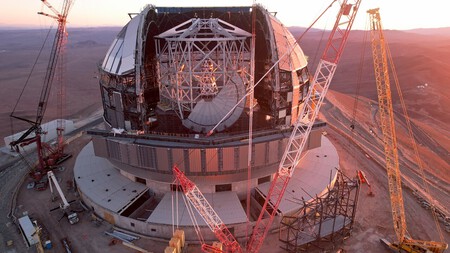The Gran Telescopio Canarias is, today, the largest optical and infrared telescope in the world. However, if everything goes according to plan, that position will go to the Extremely Large Telescope (ELT) in 2028. The project, under the orbit of the European Southern Observatory (ESO), is being developed on Cerro Armazones, in the Atacama Desert, in Chile.
Photographs taken earlier this year show the progress of the works. The framework of the enormous dome, with a diameter of 93 meters, has been completed, so the tasks now focus on the assembly of the outer cover of aluminum plates. This cover will act as a “shell” that will protect the equipment from the adverse climate of the location.
Construction of the world’s next largest telescope advances
The main protagonist of the material shared by the ESO is the high-altitude metal structure, which will be responsible for supporting optics and instruments during astronomical observations. This 50-meter-high piece will contain the five mirrors of the ELT and will have to be moved so that the telescope can point at different parts of the sky.
To talk about ELT is to refer to several milestones. The primary mirror of 39 meters in diameter will be made up of 798 individual hexagonal segmentsand it will be the largest ever built. The secondary mirror will reflect the light from the primary mirror onto the tertiary mirror. The three mirrors should offer better observations over a wide field of view.

Image: ESO/G. Vecchia | ELT under construction in January 2025
But there is more. The fourth mirror is very interesting because it is an “adaptive” mirror. It has been designed to deform to correct atmospheric turbulence and vibration of the telescope structure and its movement. Thousands of actuators intervene to give life to this feature that will deliver sharper images.


Image: ESO/G. Vecchia | ELT under construction in January 2025
The fifth mirror is the smallest, but not the least important. It is a very light and rigid optical piece that moves with great precision to ensure that the images arrive stabilized to the telescope’s instruments, that is, its multiple spectrographs and cameras that will receive the light to analyze it in detail.


Image: ESO/G. Vecchia | ELT under construction in January 2025
It’s been a long time since this project took its first steps. The preliminary design of the telescope was published in 2006 and in 2010 Cerro Armazones was selected as the ideal place for its construction. The reason was very simple: it is a place whose climatic conditions greatly favor the observation of the cosmos.


Image: ESO | ELT render
The hill is far enough from cities to suffer considerable light pollution. There is also a small percentage of precipitable water vapor. Have you ever wondered why stars blink when we look at them? It is due to the conditions of our atmosphere, such as density, temperature and wind.
The signing of the agreement between Chile and the ESO came in 2011, which included the donation of an area of 189 square kilometers for the installation of the telescope and the concession for 50 years of the surrounding area. Construction began in March 2014. The project has a budget of 1.45 billion euros and, as we say, it should be operational in 2026.

The ELT promises to capture 15 times more light than the Gran Telescopio Canarias and offer sharper views than the Hubble Space Telescope, an observatory that aims to retire soon. As we have noted, the ELT will have a 39-meter diameter mirror, key to achieving its objective: obtain direct images of exoplanetsanalyze their atmospheres and measure the expansion of the universe.
Images | ESO/G. Vecchia
In WorldOfSoftware | James Webb has just shown us waves of star dust so colossal that they would make our solar system small












